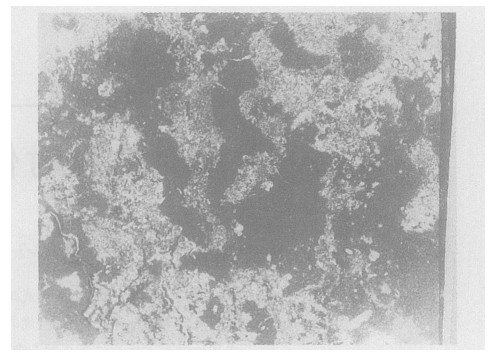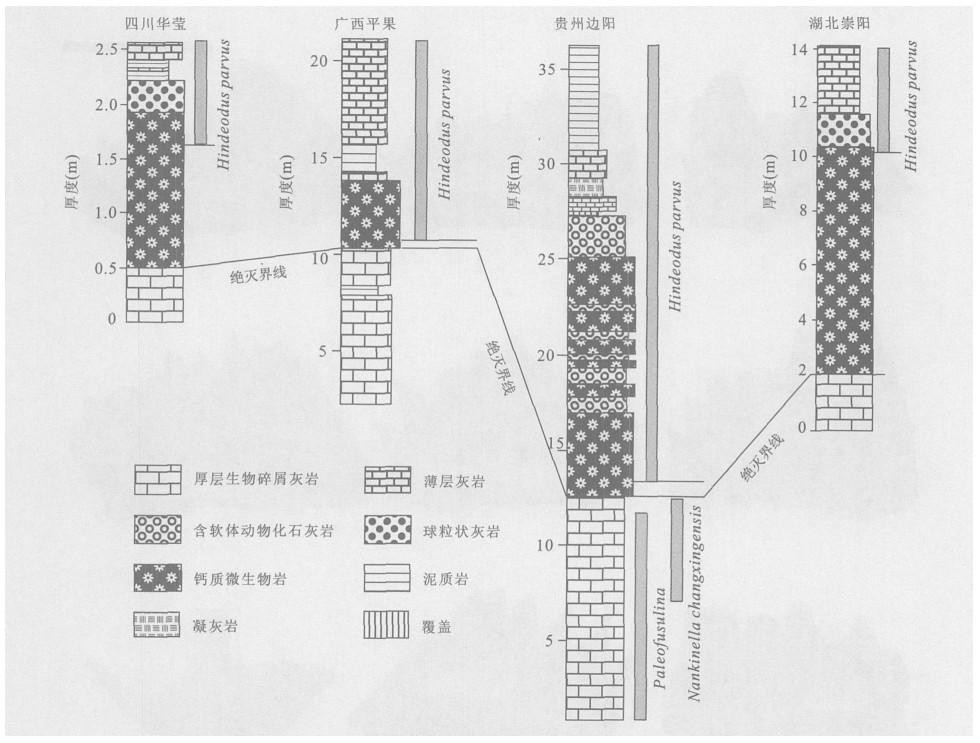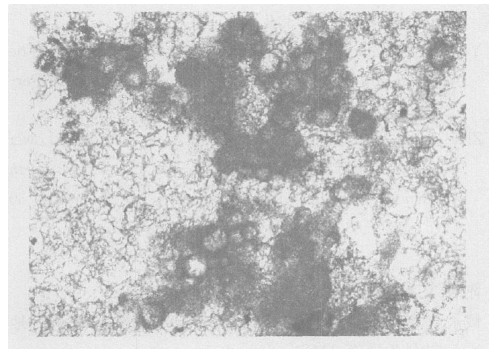Age and General Characteristics of Calcimicrobialite near the Permian-Triassic Boundary in Chongyang, Hubei Province
-
摘要: 湖北崇阳钙质微生物岩产在二叠纪末礁相绝灭界线之上, 绝灭界线之下即为晚二叠世长兴期的海绵礁灰岩、棘屑灰岩及藻有孔虫生物碎屑灰岩.微生物岩基本上由中粗晶-微晶方解石组成, 主要沉积构造有“花斑状构造”及藻叠层构造.目前微生物岩中发现的化石主要有球状菌藻类化石、介形虫、微型腹足、双壳、鱼牙及分类位置尚无法确定的棒状微型化石.微生物岩中已发现有牙形石化石: Hindeodusparvus, H.typicalis和H.latidentatus, 从牙形石的类型及产出层位分析, 崇阳钙质微生物岩的下部属于晚二叠世长兴期, 上部为早三叠世.崇阳微生物岩在沉积特征、生物组成及牙形石带上均基本可与华南其他地区已发现的微生物岩进行对比.Abstract: The microbialites of Chongyang in Hubei Province occur above the mass extinction line in the Late Permian reef facies. Below the boundary are the sponge reef limestone, crinoid limestone and alga-foraminifer bioclastic limestone of the Changxing Formation. The microbialites are generally composed of mid-coarse grains and microlite calcite with a structure of "graniphyic fabric" and stromatolite. The fossils discovered in the microbialites include globular cynobacteria, ostracods, micro-gastropods, bivalves, fish teeth and some problematical micro-fossils. Conodont fossils of Hindeodus parvus, H. typicalis and H. latidentatus were also found. According to the conodonts, microbialites spanned the Late Permian and Early Triassic in Chongyang. The upper part above the first occurrence of Hindeodus parvus should be attributed to the Early Triassic, and the low part to Changxingian. The sedimentary structure, fossil composition and conodont zonation of the Chongyang microbialites can be well correlated with the microbialites found in other areas of South China.
-
Key words:
- calcimicrobialite /
- conodont /
- end-Permian /
- Early Triassic /
- Hubei
-
图 3 华南微生物岩中Hindeodus parvus产出层位对比
四川华莹剖面, 据Kershaw et al., 2002; 广西平果剖面为本研究实测, 牙形石带, 据Lehrmann et al., 2003; 贵州边阳剖面, 据Lehrmann et al., 2003; 湖北崇阳剖面为本研究实测
Fig. 3. Comparison diagram of Hindeodus parvus horizon of the micobialites in South China
图 4 微生物岩中的牙形石化石
产地层位: 湖北崇阳剖面, 离绝灭界线(及微生物岩底) 约8.4 m; 1~2:Hindeodus parvus (Kozur and Pjatakova, 1976), 1.侧视, ×200, 2.侧视, ×300;3:Hindeodus latidentatus (Kozur et al., 1975) 侧视, ×400;4:Hindeodus typicalis (Sweet, 1970) 侧视, ×290;5:Hindeodus sp., 侧视, ×300;6.Hindeodus eurypyge, Nicoll et al., 2002; 侧视, ×240;7~8:Hindeodus inflatus, Nicoll et al., 2002; 7.侧视, ×300, 8.侧视, ×400;9~12.Hindeodus sp., 9.Sb element, 侧视, ×300, 10.侧视, ×250, 11.侧视, ×280, 12.Sc element, 侧视, ×270;比例尺: 200 μm
Fig. 4. Conodonts in the micobialites
-
Dai, Y.D., Chen, M.E., Wang, Y., 1996. Development and perspective of research for microbolites. Advance in Earth Sciences, 11(2): 209 -215(in Chinese with Enlish abstract). https://www.sciencedirect.com/science/article/pii/S0024630115000291 Fang, Z.J., 2004. Makor bio-events in Permian-Triassic reef ecosystems of South China and their bearing on the extinction-survival-recovery problems. University of Science and Technology of China Press, Hefei, 475 - 542(in Chinese). Lai, X.L., Zhang, K.X., 1999. A new paleoecological model of conodonts during the Permian-Triassic transitional period. Earth Science— Journal of China University of Geoscences, 24(1): 33 -38(in Chinese with English abstract). Lehrmann, D.J., 1999. Early Triassic calcimicrobial mounds and biostromes of the Nanpanjiang basin, South China. Geology, 27(4): 359 -362. doi: 10.1130/0091-7613(1999)027<0359:ETCMAB>2.3.CO;2 Lehrmann, D. J., Payne, J. L., Felix, S. V., et al., 2003. Permian-Triassic boundary sections from shallow-mrine carbonate platforms of the Nanpanjiang basin, South China: Implications for oceanic conditions assocated with the end-Permian extinction and its aftermath. Palaios, 18(2): 138 -152. doi: 10.1669/0883-1351(2003)18<138:PBSFSC>2.0.CO;2 Kershaw, S., Zhang, T.S., Lan, G.Z., 1999. A microbialite carbonate crust at the Permian-Triassic boundary in South China, and its palaeoenvironmental significance. Palaeogeography, Palaeoclimatology, Palaeoecology, 146: 1 -18. doi: 10.1016/S0031-0182(98)00139-4 Kershaw, S., Guo, L., Swift, A., et al., 2002. Microbialites in the Permian-Triassic boundary interval in central China: Structure, age and distribution. Facies, 47: 83 -90. doi: 10.1007/BF02667707 Kozur, H. W., Mostler, H., Rahimi-Yazda, A., 1975. Betrage zur mikrofauna Permtriasdischer schichtfologen. TeilII: NeueconodontenausdemOber Perm und der basalen Trias von Nord-und Zentraliram. GeologischPalaontologische MittelungenInnsbruck, 59: 1 -23. Kozur, H. W., Pjatakova, M. V., 1976. Die Conodontenart Anchignathodus parvus n. sp., eine wichtige Leftform der bassaien Trias. Koninklijke Nederlandse Akademie van Wetenschappen Proceeding(Series B), 79(2): 123 -128. Kozur, H.W., 2004. Pelagic uppermost Permian and Perman. Triassic boundary conodonts of Iran. Part 1: Taxoomy. Hallesches Jahrbuch Geowissenscha ften, Reihe B, Beiheft, 18: 39 -68. Nicoll, R.S., Metcalfe, I., Wang, C.Y., 2002. New species of the conodont genus Hindeodus and the conodont biotratigraphy of the Permian-Triassic boundary interval. Journal of Asian Earth Sciences. 20(6): 609 -631. doi: 10.1016/S1367-9120(02)00021-4 Sweet, W. C., 1970. Permian and Triassic conodonts from Guryul Ravine, Vihi District, Kashmir., Univ, Kansas Paleont. Contr., Paper, 49: 1 -10. Wang, Y.B., Tong, J.N., Wang, J.S., et al., 2005. Calcimcrobialite after end-Permian mass extinction in South China and its palaeoenvironmental significance. Chinese Science Bulletin, 50(6): 552 -558(in Chinese). doi: 10.1360/972004-323 Yin, H.F., Yang, F.Q., Zhang, K.X., et al., 1986. A prposal to the biostratigraphic criterion of the PermiaTriassic boundary. Memerie Deiia Societa Geological Italiana, 36: 329 -334. Yin, H. F., Zhang, K. X., Tong, J. N., et al., 2001. The global stratotype section and point(GSSP)of the Pemian-Triassic boundary. Episodes, 24: 102 -114. doi: 10.18814/epiiugs/2001/v24i2/004 Zhao, L.S., Tong, J.N., Orchard, M.J., et al., 2005. Lower Triassic conodont zonations of Chaohu area, Anhui. Earth Science— Journal of China University of Geosciences, 30 (5): 623 -634(in Chinese with English abstract). 戴永定, 陈孟莪, 王尧, 1996. 微生物岩研究的发展与展望. 地球科学进展, 11(2): 209 -215. doi: 10.3321/j.issn:1001-8166.1996.02.016 方宗杰, 2004. 从华南二叠纪-三叠纪礁生态系的演变探讨与灭绝-残存-复苏相关的几个问题. 见: 戎嘉余, 方宗杰, 生物大灭绝与复苏-来自华南古生代和三叠纪的证据. 合肥: 中国科学技术大学出版社, 475 -542. 赖旭龙, 张克信, 1999. 二叠-三叠纪之交牙形石生态新模型. 地球科学——中国地质大学学报, 24(1): 33 -38. https://www.cnki.com.cn/Article/CJFDTOTAL-DQKX901.005.htm 王永标, 童金南, 王家生, 等, 2005. 华南二叠纪末大绝灭后的钙质微生物岩及古环境意义. 科学通报, 50(6): 552 -558. doi: 10.3321/j.issn:0023-074X.2005.06.009 赵来时, 童金南, Orchard, M. J, 等, 2005. 安徽巢湖地区下三叠统牙形石生物地层分带及其全球对比. 地球科学——中国地质大学学报, 30(5): 623 -634. https://www.cnki.com.cn/Article/CJFDTOTAL-DQKX200505015.htm -










 下载:
下载:





